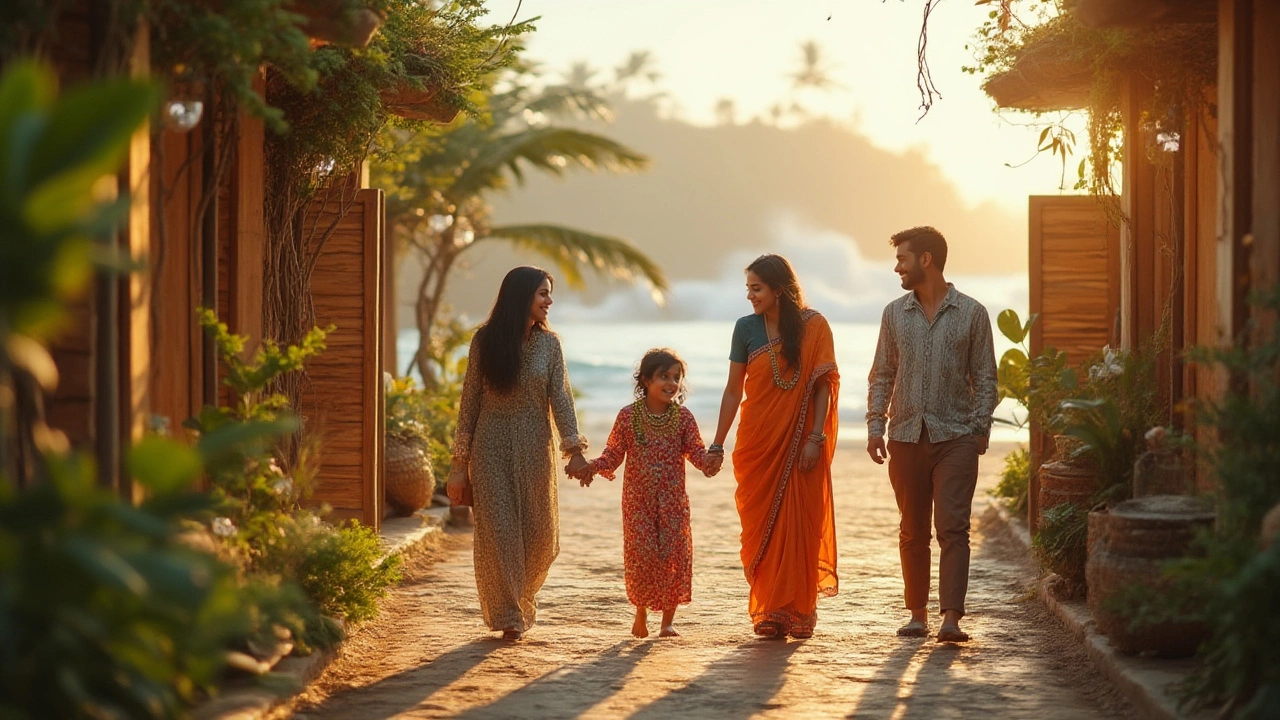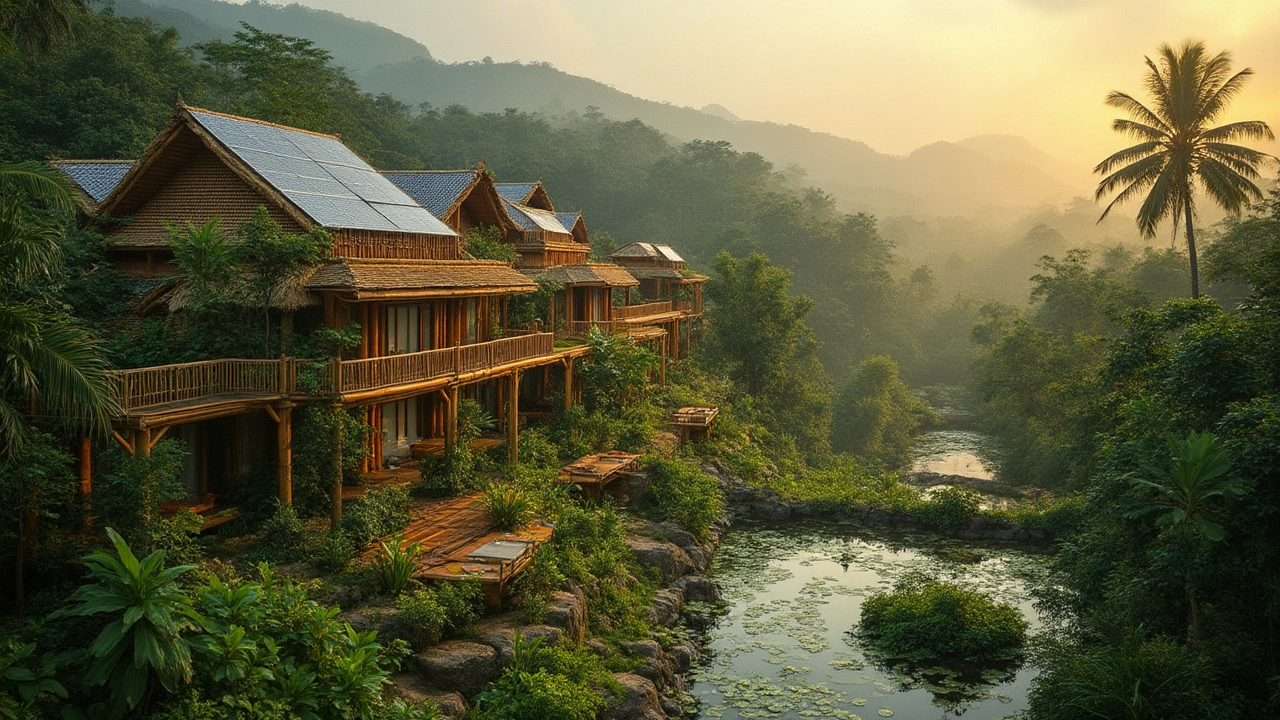Imagine waking up to the soft sound of waves, knowing that even your morning shower is powered by sunshine and your breakfast supports the local farmers just down the road. People used to think luxury and saving the planet couldn’t go hand in hand. Today, eco-friendly resorts are proof that you can enjoy five-star pampering and keep your environmental footprint as gentle as sea foam. Green travel isn’t just about refusing plastic straws at the bar. It’s about how the entire resort runs—energy, water, food, architecture, even the job contracts with local communities. It’s a revolution happening quietly from Bali to the Maldives, Costa Rica to Queenstown, with guests loving the idea that they can relax in paradise and do something genuinely good just by being thoughtful about where they stay.
What Is an Eco-Friendly Resort, Really?
To understand the eco-friendly resort concept, let’s break it down. At its core, an eco-friendly resort is a place to stay that puts the planet first, not afterthought. These resorts blend high comfort with real initiatives to reduce waste, conserve energy and water, respect local ecosystems, and often give more to their community than they take. No, this isn’t just turning the lights off at night or swapping towels every other day—those are just the basics. True eco resorts think bigger: they might harvest rainwater, use solar panels, and build with bamboo or recycled materials. Some have living roofs thick with wildflowers to help native bees and birds. Others run organic farms and invite guests to join a tree planting day. They work for the area’s good, not just their guest ratings.
Take Soneva Fushi in the Maldives. This off-the-charts luxurious spot recycles up to 90% of its waste, including glass, with their own on-island recycling plant. Have you seen resorts that made playgrounds and mosaic tiles from used wine bottles? They do. And that’s just one example. In New Zealand, some eco lodges use wool for insulation and plant native trees for every guest that stays. These efforts aren’t just box-ticking—they’re woven throughout the resort’s DNA. Why so important? Tourism, according to the UNWTO, counts for 8% of global greenhouse emissions and can put massive pressure on fragile habitats. By being truly eco-friendly, resorts aren’t only reducing harm, but are actively creating net-positive impacts for destinations.
Here’s a snapshot of what makes a true eco resort stand out from regular hotels:
- Local and natural building materials (think wood, recycled brick, bamboo)
- Energy-efficient systems: solar panels, LED lighting, geothermal heating/cooling
- Water-saving fixtures, rainwater harvesting, on-site wastewater treatment
- Buying food from local, sustainable suppliers (some even grow their own)
- Waste minimization and recycling programs
- Hiring and uplifting local staff, supporting community projects
Some will even have turtle conservation programs or fund local schools. And the guest experience? It’s just as luxurious as any top-tier hotel—often even more memorable because you know your stay is having a positive effect. That makes the sunsets taste sweeter, there’s no doubt about it.
Sustainable Design and Architecture: More Than Trendy Looks
You might not notice it instantly, but the way an eco resort is designed can have a massive impact. We’re not talking just the odd potted plant or recycled wood sign. Builders and architects behind true eco resorts sweat every detail to make sure the resort actually fits into its environment and sometimes even improves it. You’ll see accommodations positioned for natural cross-ventilation to keep cool without cranking up the air con. Roof angles catch sunlight for solar panels and shade walkways to reduce heat. You might spot green roofs—these aren’t just pretty, they insulate rooms to lower energy use and attract birdlife. Some beach resorts are raised on stilts so the roots below don’t get smothered, letting mangroves and local crabs keep thriving.
It’s not just about green tech—it’s about blending with the landscape, so you’re seeing fewer bulldozers and less habitat destruction. For example, look at the Fogo Island Inn in Canada, built using local spruce and held up on stilts to minimize impact on the ancient rocks below. Or the Southern Ocean Lodge in Australia, using curved roofs to mimic surrounding hills and resist strong Antarctic winds. Even eco resorts in Bali like Bambu Indah use old teakwood houses and natural pools filtered by lava stone rather than harsh chemicals.
Often, every detail inside your room is chosen for sustainability—from organic linen sheets to refillable ceramic amenities bottles (bye-bye tiny plastic toiletries). Many resorts ban single-use plastics entirely—no plastic water bottles, no plastic wrap around your sandwich, not even plastic pens at the front desk. There’s also thoughtful landscaping; native plant gardens use less water than imported lawns and provide homes for native butterflies and birds. Zero-waste kitchens pop up at some luxury eco resorts, meaning every carrot top or fish bone gets used in stocks or compost.
People sometimes ask, isn’t this crazy expensive? Not always. Costs for freshwater and electricity drop dramatically, and even luxury properties like Song Saa Private Island in Cambodia report big long-term savings from investing in sustainable design upfront. Here’s a quick look at some common features and their environmental impact:
| Sustainable Feature | Environmental Benefit |
|---|---|
| Solar panels | Cuts carbon emissions, renewable energy |
| On-site organic farms | Lowers food miles, supports biodiversity |
| Rainwater collection | Reduces freshwater use and stormwater runoff |
| Natural pools | No chemicals, supports wetlands |
| Native landscape gardens | Less watering/mowing, wildlife habitat |
The big win here? You stay cool, comfortable, and inspired, while the place you’re visiting stands a bit stronger than before—proving that design can do way more than just look pretty for Instagram.

Community, Culture, and Local Impact
Eco-friendly resorts aren’t just about what happens behind closed doors. The best ones act almost like unofficial ambassadors for their places, making sure the money and attention from visitors actually benefit the area, not just distant shareholders. That means hiring staff from nearby villages and paying them fairly, investing in education, and supporting projects that protect cultural heritage or natural spots everyone loves. It’s about respecting and enriching local traditions, not just parachuting in a chain hotel blueprint and calling it a day.
If you wander into the village near Niseko, Japan, the people working at the region’s award-winning eco lodges might be the same folks guiding you on snowshoe treks, leading cooking classes on traditional food, or teaching guests about endangered species living nearby. In Costa Rica, eco-lodges often donate a portion of bookings to wildlife corridors and local schools. Guests are regularly invited to community-led events, like local craft fairs or tree planting days—and these aren’t staged or ‘touristy’ but real, two-way exchanges that stick with travelers long after check-out.
This isn’t charity work—it’s smart business for everyone. Resorts can create a ripple effect: locals gain better opportunities and training (think chefs, guides, conservation officers), while guests get a far richer, more authentic experience. Cultural tourism flourishes, rather than flattens—because the stories, recipes, art, and languages of the region are valued, not wiped away by generic globalization.
A few eco resorts do this brilliantly. For instance, the Cristalino Lodge in Brazil trains and employs local guides who know the rainforest better than any imported expert ever could. Soneva runs a foundation funding safe water and health clinics all through the Maldives, while Six Senses in Vietnam directly invests in education and wildlife conservation on its home island. Here are a few ways eco resorts shape local life for the better:
- Prioritizing local food, products, and talent for sourcing
- Offering educational workshops or language classes for staff and their families
- Funding and participating in conservation days—like coral planting or bird monitoring
- Encouraging respectful cultural exchange, not token shows
- Supporting women’s collectives, indigenous artisans, or rural entrepreneurs
Travelers today are getting savvier—many ask about wages, working conditions, and what the resort gives back before they’ll book. Bottom line? If a resort feels like a bubble sealed off from its surroundings, it’s missing what makes eco-friendly travel matter most—leaving the place better than you found it, and taking home more than just pretty photos.
How to Choose and Get the Most from an Eco-Friendly Resort Stay
So, how do you know a resort is truly green and not just slapping a leaf logo on their website? It’s called greenwashing, and it’s sneaky. The best eco-friendly resorts go way past lip service and actually let their guests see (and take part in) what they’re doing. Look for recognized third-party certifications—like Green Globe, EarthCheck, or LEED—or check if they publicly share sustainability audits and impact reports. Don’t be shy to ask about their water and waste policies, energy sources, and how they involve local people. A hotel dodging these questions probably isn’t as green as it says.
If you’re planning your next getaway, here’s a cheat sheet for finding and getting the most out of a strong eco-friendly resort experience:
- Ask for Proof: Don’t just trust a few green buzzwords. Look for transparent info on their website or via email—don’t hesitate to ask for specifics on certifications and local partnerships.
- Check the Menu: Good eco resorts brag about their local food. Expect plenty of regionally sourced options, organics, and dishes featuring what’s in season (with less beef and imported seafood).
- Tour Their Operations: Many places offer behind-the-scenes tours—see the solar array, composting facility, or native garden. Ask if you can join volunteer days or conservation projects during your stay.
- Travel Light: Even eco resorts struggle if guests bring tons of plastic or water bottles. Pack reusable water bottles, bags, plus reef-safe sunscreen if you’re headed to the beach.
- Be Respectful: Support local initiatives—book village visits, attend cultural activities led by residents, and spend at least a little of your travel budget in small shops, not just on-site boutiques.
- Leave Reviews: Share your experience online with real details—what was genuine, what felt greenwashed—so other travelers (and the resorts) can step up their game.
There’s a sense of pride and joy knowing your getaway didn’t just pamper you, it helped other people and the very planet you enjoyed. And honestly, once you’ve slept with the sea breeze through real wood shutters, dined on tomatoes grown two minutes away, and swum in a pool cleaned by plants, you’ll want every vacation to go green. Real sustainability isn’t about sacrifice; it’s about getting richer experiences, softer footprints, and way better travel stories to take home.
